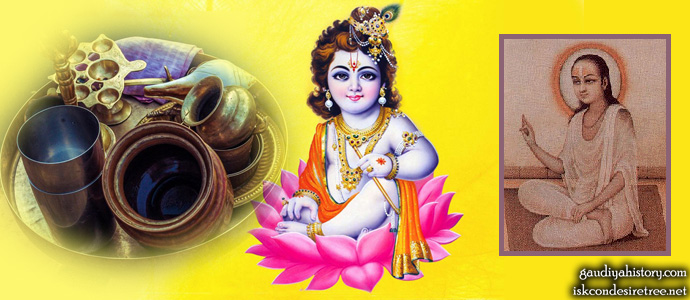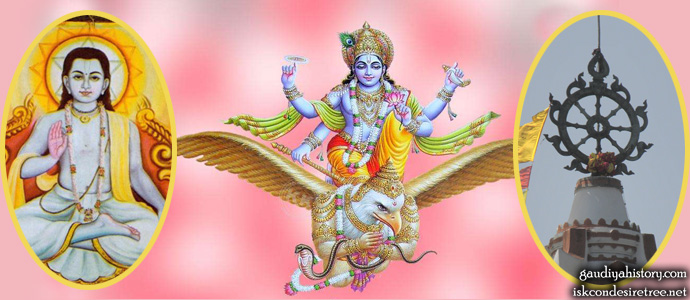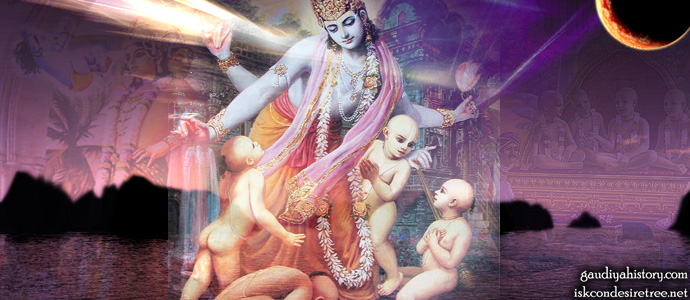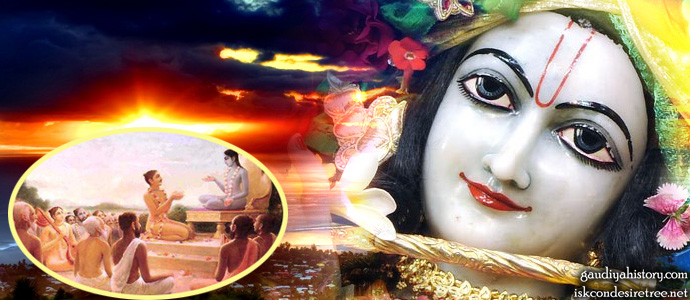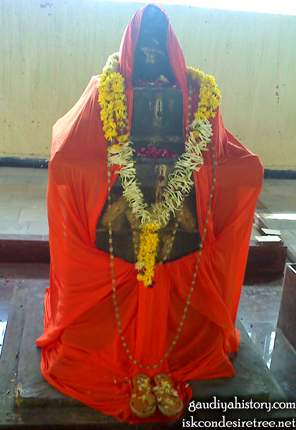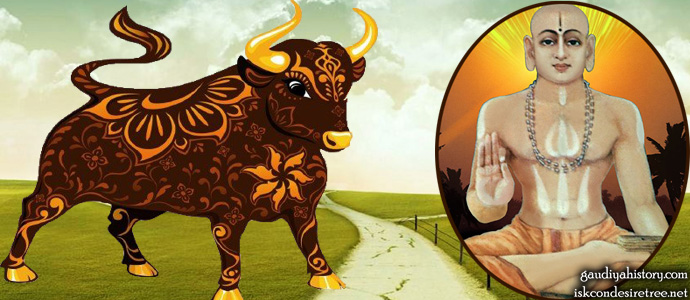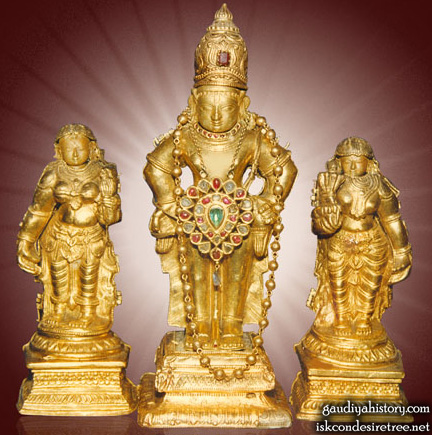Otherwise known as Shrila Vyasaraya and Shrila Vyasaraja Swamin, as we briefly mentioned, he was the disciple of Shripad Brahmanya Tirtha. He was the fourth in decent from Rajendra Tirtha.
Born around 1460 A.D., in the village of Bannur in Mysore District, (Vyasayogicharita, 1926. Bangalore. page 13), his father's name was Ballanna Sumati and his gotra was Kashyapa, the youngest of six sons of Ramacharya. As his first wife was childless for a long time, he married a second girl called Akkamma. In this regard 'Sumati' is given as his surname, and Ballanna might be deemed to be the collquial variant of Balarama. (B.N.K. Sharma. 1961. History of the Dvaita school of Vedanta. page 286.)
As previously stated, Vyasa Tirtha took his birth by the blessings of Brahmanya Tirtha. Altogether, Shripad Vyasa Tirtha's parents had three children, a girl and two boys. In his childhood Shripad Vyasa Tirtha was known as Yatiraja, it is suggested to honour Shripad Brahmanya Yati his father's 'Guru'. At the age of five Yatiraja underwent the Vidyarambha samskara to begin his formal education, starting with writing the alphabet, and at seven years took 'upanayana', investiture with the sacred thread. He stayed at 'gurukula' for only four years after that. At eleven he went to his home and continued his studies of poetry, drama and grammar for about five years.
Before Shripad Vyasa Tirtha's birth, his father, Ballanna promised his second son to Brahmanya Tirtha whom he was very close to. Despite the families deep attachment to this young boy, to show his determination to fulfil this deed as promised to 'Guru' he gave the boy the named Yatiraja over to Brahmanya Tirtha. His name not only indicates that he was destined as the 'property' of Bramanya Tirtha, but also the boy's future as a renunciate. And so in due course Ballanna personally took his son to Cannapatna and presented to Brahmanya Tirtha as an assistant, the father then returned home.
"Brahmanya Tirtha was very much impressed with the superior attainment of his ward and was secretly meditating to ordain him a monk, so as to enlist his genius to the cause of Vaishnava Dharma." (B.N.K. Sharma. 1961. History of the Dvaita School of Vedanta. page 287.)
Some commentators say that Yatiraj knew of the intention of Brahmanya Tirtha, but didn't want to commit himself, and so took of for his freedom, one day. However more devotional commentators say that after some time, however, Yatiraja, being unsure of Brahmanya Tirtha's intentions, slipped away and ran into the forest and headed for the direction of "home," away from the hermitage. One night whilst sleeping in the forest under a tree, Lord Vishnu came to him and told him what He had planned for him, and that the Lord was looking after him. Lord Vishnu then told young Yatiraj what to do. The teenager returned to the 'ashrama' hermitage that very same day, and shortly after this, upon proving his dedication to his 'guru', young Yatiraja was formally initiated into the 'sannyasa' order and given the name Vyasa Tirtha.
Some time shortly after the two year famine of 1475., and 1476., Brahmanya Tirtha, his 'guru', left this world. Shripad Vyasa Tirtha came to the Vedanta Pitha about 1478., in his late teens, sixteen. Due to his young age and little time spent with his 'guru', some said that he didn't really know the conclusions of the Madhva 'shastras' very well, so he went to Kanchipuram to study, where, after a very short time, he became a renowned pandit. It is suspected that it was at this time that Vyasa Tirtha developed his profound knowledge, understanding and refutory power in all the scriptures. Kanchi was at that time the citidel of shastric learning of all South India. Vyasa Tirtha stayed for many years there studying the six systems of philosophy, under eminent pandits there. He acquired deep erudition in all the systems of philosophy, even Shankara and Ramanuja, as well as the Bhatta school, Nyaya, and an acquaintance which stood him in good stead, in writing his monumental works, the Nyayamrta, Tatparya Chandrika and Tarkatandava.
In local history corresponding to the time, it is mentioned that the saintly King of Bisnaga used to listen daily to a great Brahma Madhva Vaishnava 'sannyasi' who had never married or touched a woman in his life. Though his name is not directly mentioned, history infers that this was Shripad Vyasa Tirtha.
From Kanchipuram he went over to the seat of Shripadaraja at Mulbagal which was also another great seat of learning like Kanchi.
Shripadaraja was also known as Lakshminaryana Tirtha (1420-1487.), although he was more widely known as Shripadaraja. He was the pontiff of the Mutt of Padmanabha Tirtha at Mulbagal, and seventh descendant and successor to Svarnavarna Tirtha, whose Brindavan-samadhi was discovered at Shrirangam. According to tradition, the mothers of Brahmanya Tirtha and Shripadaraja were uterine sisters, the cousins were about the same age. Shripadaraj's father was said to have been a contemporay of Raghunatha Tirtha of Uttaradi Mutt, who came into office in 1444., and died in 1502.
Vyasa Tirtha is believed to have read under Shripadaraj for nearly twelve years (Vidyaratnakara Tirtha Swami of Vyasaray Mutt, Vy-charita, lxxiii, introduction.). Others say it was only five to six years (B.N.K. Sharma. 1961. History of the Dvaita School of Vedanta. page 288.). "It is remarkable that both should have renounced the world and devoted themselves to the cause of their faith and played a conspicuous part in the spiritual development of their gifted disciple Vyasa Tirtha."(B.N.K. Sharma. 1961. History of the Dvaita School of Vedanta. page 461.).
From there on the advice of Shripadaraj, Vyasa Tirtha went to Vijayanagar and the 'Kings Court' (approx 1485-86.), and became known for his radical statements regarding Brahmanism, Vaishnavism, Varnashrama, and who was worthy to worship the Lord.
The latter part of the biography of Vyasa Tirtha (Vyasayogicharita, chapter IV.) gives a brilliant account of the arrival of Vyasa Tirtha, at the court of Saluva Narasimha at Chandragiri, and the grand reception that they had there for him. Being worshipped by the king bathed in presious jewells, pure gold and silver powders, and presented with all kinds of oppulences befitting such a worthy 'acharya'. Vyasa Tirtha spent a couple of years there in this way being honoured by the king.
Here he met and vanquished in intellectual debating tournaments many of the leading scholars of his day and conducted debates on such treatises on Logic as the Tattvachintamani of Gangesha.
Whilst in that area he was entrusted with the worship of Shrinivasan, Lord Vishnu, at Tirupati (Tirumala). Shripad Vyasa Tirtha's Mutt is still at Tirupati on the hill of Tirumala. Before leaving that place, after about twelve years of being there (1486-98.), he gave the worship over to his disciples. His South Indian tour must have come at this time (B. Venkobarao. Notes to Vy-carita. page 18.)
According to the commentator Somanatha, Vyasa Tirtha returned to Chandragiri for a while after 1498. He evidently did so at the request of Saluva Immadi Narasimha, the son and successor of Saluva Narasimha, untill Narasa Naque became defacto ruler of Vijayanagar soon after the settlement which he concluded with King Tamma Raya, in 1498., (Proddattur 386 of 1904, Madras Insc. B.N.K. Sharma. 1961. History of the Dvaita School of Vedanta. page 289.).
Once, Shripad Vyasarya foresaw with his mystical powers that the emperor of Vijayanagar would be subjected to some very intense, focussed bad influence of planets known as Kuhay Oga. To protect his Devotees, and the Vijayanagar empire, Shripad Vyasa Tirtha (Vyasaraya) himself ascended the throne during those evil moments. The combined, concentrated effect of those forces was a raging inferno that had the capacity of buring down the throne and the entire palace. Shripad Vyasa Tirtha smothered the fire with his holy shawl ('angavastra)' and protected his Devotees. Later, he handed the empire back to Raja Krishnadevaraya his loyal Devotee. This great miracle has been faithfully described in several songs by Haridasas (the Dasakutas). And to commemorate this event, even to this day the 'Swamijis' of the Vyasaraya lineage hold a 'durbar' (court presided over by a king in his honour). This is perhaps the only known instance where a saint holds court.
It was at this time that Vyasa Tirtha was installed at the helm of the Vijayanagara kingdom as the 'guardian saint'. This position was conferred upon him without any challenge.
It was at this time and place where he was challenged to a debate by 'brahmana pandits' from all over India. The 'pandits' were led by the learned 'brahmin' Basava Bhatta of Kalinga, Orissa. They all pinned their challenges to the pillars of the palace. After a thirty day discussion, Shripad Vyasa Tirtha emerged triumphant, and his reputation earned him the respect of King Krishnadevaraya 1509 A.D., who regarded him as 'guru' and gave him all honours as such. Maharaj Krishnadevaraya opened a new chapter in the glory of Shripada Vyasa Tirtha a chapter more brilliant than any that had gone before. Raja Krishnadevaraya in fact had the greatest regard and respect for Vyasa Tirtha and reffered to him as his 'Kuladevata'.
Krishnadevaraya had awarded Shripad Vyasa Tirtha the order of the camel on a green flag by 1500 A.D., and a drum on the back of a camel banner as a mark of respect. This is still kept by the Shrila Vyasaraya Mutt at Gosale. Once the flag was taken by King Nrsimha in his attacks against the Muslim sultans who caused threats and violence to Devotees and Temples in South India, but between these saintly Kshatriya Kings Krishnadevaraya, Nrsimha, Shivaji and others, the sultans were stopped before getting very far.
In 1511 A.D., the king gave him a village, Pulambakkam in the 'Padaividu-rajyam', for conducting the 'Avaham' ('avani'), installation festival of the Lord Varadaraja at Kanchi in the king's name, and for also the king's saction fro presenting a Sheshavahan of gold, which had to be used as a vehicle for the Lord on the fourth day of all the festivals. (Madras Epi. Rep. 1912-20, no. 370 of 1919.)
In an inscription on the southern wall of the Mantapa in front of the Vittalswami Temple, at Hampi, which records a grant to the Temple in 1513 A.D., by Raja Krishnadevaray, Vyasa Tirtha is refered to as the 'Guru' without any prefix whatsoever. (S.I.I. IV, no. 48 of 1889 – Kannada.; B.N.K. Sharma. 1961. History of the Dvaita School of Vedanta. page 290.).
There are many nice stories telling of the great King Krishnadevaraya, who ruled the famous Vijayanagar kingdom on the Tungabhadra River in Karnataka in connection with his 'guru'.
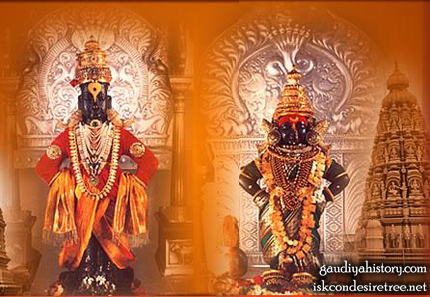
Krishnadevaraya had made beautiful Deities of Shri Vittala (Krishna) and Rukmini, and established the fine Vittala-Rukmini Temple which still stands there today. (In the image: Shri Shri Vittal Rukmini).
Shripad Vyasa Tirtha gave the King formal initiation, and then out of gratitude and love for his 'guru', Krishnadevaraya had made beautiful Deities of Shri Vittala (Krishna) and Rukmini, and established the fine Vittala-Rukmini Temple which still stands there today.
Unfortunately this Temple was very badly damaged by the Mogal invaders some time after the demise of Raja Krishnadevaraya. The Mogals had for nearly two centuries tried to conquer this mighty Vaishnava kingdom. The kingdoms' demise to what it is now, came about not so much from the attacks of the Muslimads (Mussalmans), but from the curse of a dying 'brahmin'. The story is recorded that once the Muslim invaders, lead by Mujahid, entered the outer part of the city and dispersed, killing many of the 'brahmanas' who lived there. (This place is the old Kishkinda forest mentioned in the Ramayana, and birth place of the son of Vayu, Hanuman. There is a huge Deity of Hanuman made from one singular granite stone at that place.) The invading sultan chopped the priests to the ground and then struck the Deity of Hanumanji in the face. A dying priest was heard to say, "For this act you will perish here and also this city will withdraw its opulences from you. You have brought about the end of your life." Then he gave up this world, as later did the sultan. The Deity of Hanuman is still there to this day with the marks of the attempt to harm him slightly visible. This town which is the site of the ancient Vijayanagar kingdom and which is now known as Hampi, is just a short bus ride from Hospet, which is on the main railway line in Northern Karnataka (Hubli-Belguam line).
On the Temple wall there are inscriptions giving the date 1513 A.D., and refers to Shripad Vyasa Tirtha as the 'guru' of Raja Krishnadeva-raya. There is also mention of Shripad Vyasa Tirtha ceremonially bathing Shri Krishnadevaraya at his initiation, following in the method of Shripad Madhvacharya's 'puja' manual entitled "Tantrasara" Chapter 2:10-11., in which the Tantrasara points out that the ceremonial bathing, 'abhisheka' of a disciple by the 'guru' adds to the glory of the disciple. As we can see by the next brief story, this did make him glorious.
Vyasa Tirtha whose Nyayamrta is a wonderful work on Vedanta is sometimes compared to Lord Vishnu's firery Sudarshan discus, infallable, and deadly a weapon, used against the 'mayavadins' who had to admit its unfathomable depth of devotion, and intellectualism. The infamous 'mayavadin' Madhusudan Saraswati of the Sankarite school wrote 'Advaita-Siddhi' as a rejoiner to it, but failed to take up the challenge.
Shripad Ramachandra Tirtha from among the Madhva line in his Tarangini refuted the arguments contained in the said Advaita-Siddhi. The Shankarite scholars in their turn turned offered Brahmanandiya in answer to the questions put forward in Tarangini. The Madhvas had again written Vamamalma Shriya to silence their natural enemies. It is really a wonderful and interesting study, how obstinately the two schools fought each other. (Sambidananda dasa. 1991. The History & Literature of the Gaudiya Vaishnavas and their relation to other medieval Vaishnava Schools. page 104.)
Once a Gajapati King of Orissa tried to humiliate Krishnadevaraya by sending 'adwaitin', 'mayavadi' philosophical points to him to try to catch him out, but on the instructions and potency of his 'guru' Shripad Vyasa Tirtha, Shri Krishnadevaraya was, as usual, victorious. Out of gratitude Krishnadevaraya gave the village of Bettakonda to Shripad Vyasa Tirtha in 1526 A.D., and a huge lake was dug for the pleasure of 'guru' called Vyasa-samudra. The dates vary from 1523, 1524 and 1526 A.D., by various records, but all the points are substantiated by the writings of Devotees of the time, including Purandara dasa. It is also recorded that Krishnadevaraya literally bathed his 'guru' Vyasa Tirtha in jewels as well, performing "Ratnabhisheka", bathing him in jewels. Generally to install a person, an 'abhisheka' is done with ghee, milk, yogurt, honey, sugar-water and tender coconuts in this part of the country, but as well as this, it was done with priceless gems.
After the death of Krishnadevaraya in 1530 A.D., Achyutaraya continued to honour Shripad Vyasa Tirtha for a few years until his demise. Raja Shri Krishnadevaraya, by the way, is always referred to as probably the most spiritually enlightened of the Vijayanagar dynasty. He established many fine Temples and Deities in this area under the guidance of Shripad Vyasa Tirtha. To this day there still stands the Deity of Laxmi Nrsimha that I have personally seen standing twenty five feet tall in the banana fields. The Deity was carved from one stone under Krishnadevaraya's instructions. After his demise, the invading Muslims smashed many Temples out of their envy of Vaishnava culture. Many Deities like Shri Vittala Rukmini and Krishnaswami were moved further south, but although the Muslims tried to smash the Deity of Lord Nrsimha, still He stands, although His Temple lies in rubble around Him. As I hinted at previously this old and sacred place is the forest abode of Kishkinda mentioned in the Ramayana where Hanuman was born, and where Lord Rama killed Vali and, put Sugriva on the throne. Many remnants of those days exist to this day for the fortunate ones who get to visit this place.
There are numerous glories of Shripad Vyasa Tirtha to be sung. It is not unintentional that I have said "sung" in his connection, for the highly controversial and powerful preacher, the third moon of the Madhva line, was always absorbed in 'Harinama sankirtan'. Many say this was due to the influence of his teacher, Shripadiraja Tirtha Swami, who is reknowned for his poems and songs glorifying Lord Shri Krishna. Some say he was the instigator of the 'Hari dasa' or 'Dasakuta' Movement, which is further discussed in the section at the back of this book entitled "Modern day Madhvas". Anyway, during his life Shripad Vyasa Tirtha established 732 Temples of Hanuman, and or Rama, all over South India and composed numerous poems and songs based on the Shrimad Bhagavatam, Mahabharata and Ramayana.
One day after composing his famous work called "Krishna Ni Begane Baro" which, for the last four centuries has become a Bharat Natyam dance, a strange thing happened.
Shripad Vyasa Tirtha was taking a little rest when Lord Shri Krishna appeared in his dream and proceeded to address him. "You are a 'sannyasi', you do not have any wife or children. On the other hand, I am very much married and have a large family – so why is it that you only call Me Krishna?" From that day on in any further compositions, Shripad Vyasa Tirtha always referred to his Lord as "Shri Krishna".
Once Shripad Vyasa Tirtha was sitting upon the Vedanta Pitha amongst his many, many disciples, when out of nowhere one low-born farmer happened to come into the assembly requesting mantra diksha initiation from Shripad Vyasa Tirtha. The farmer humbly begged, but in his humility he was persistent. The many other disciples, who were mostly from 'brahmana' stock, viewed him as being completely unqualified due to his birth and education, or rather lack of it – not being born in a 'pukka brahmin' family like all the other disciples. Shripad Vyasa Tirtha however, being pure and free from bodily conceptions of birth, etc, was of a different mind and to everyone's amazement Shripad Vyasa Tirtha told the farmer to chant the name of Yamaraja's bull. Going away and coming back after some time after chanting that name, the farmer's voice was again heard. "Swamiji, Swamiji, he is here," the farmer exclaimed. When the Devotees peaked outside the Mutt, to their surprise there was Yamaraja's bull Mahisa, big as a mountain, right there outside the door of the Mutt. "Now what shall I do Swamiji?" the farmer enquired from Vyasa Tirtha. Shripad Vyasa Tirtha instructed him to take the bull to the river where there was one huge boulder that hundreds of men couldn't move. The farmer went to the river and requested the bull to move the boulder out of the main stream of the river to allow the water to flow to reach the crop irrigation areas downstream. That rock, which was in itself like an island amidst the river, the bull submerged beyond sight simply with the lifting of his hoof and resting it upon it. To the delight of everyone the water again began to flow. Soon after this incident the bull returned to Yamaraja, his master. The farmer then returned to Shripad Vyasa Tirtha and asked him for more service. Shripad Vyasa Tirtha, who was always compassionate, then engaged him in looking after the Mutt's goshalla.
Not long after that, an annual festival for the Deity came around on the calendar, and a huge festival was put on for the Lord. The high point was the 'abhisheka' bathing ceremony in which the Deity was to be bathed in many different auspicious by-products of the cow. However, just as the bathing commenced, the Deity of Udupi Krishna suddenly disappeared right in front of the assembly's eyes. Everyone was very confused except for Shripad Vyasa Tirtha, who asked all the assembled Devotees to conclude as to what had happened. The debating took some time, and the disciples came to their conclusion that due to the offence of allowing the low-born farmer to look after the cows and procure the milk, yogurt, ghee, etc., even though for the 'puja', the Lord had disappeared.
Indirectly they were blaming their 'guru', saying that this was his offence, for they were still on the bodily concept of life, thinking themselves as 'brahmanas' and he to be a mere 'vaishya', farmer.
Shripad Vyasa Tirtha very tolerantly tilted his head and asked everyone to follow him for a moment. Everyone, the whole festive assembly went to the 'goshalla' headed by Shripad Vyasa Tirtha. As they looked into the 'goshalla' they saw the farmer scrubbing down the cows, brush in one hand and a bucket of water in the other singing the glories of Gopal Krishna. In his total absorption of serving the Lord's cows, the farmer didn't even notice that the Deity of Udupi Krishna had manifested His normal Gopal form and was standing beside him holding the bucket for him.
Needless to say, all of his disciples were amazed that Udupi Krishna personally served this non-'brahmin' farmer, but Shripad Vyasa Tirtha explained that, "No, the Lord had come to serve His pure Devotee. Previously He came for Acharya Madhva to have him glorified, and now he has found another worthy soul." Shripad Vyasa Tirtha later formally initiated the farmer as his disciple.
Shripad Vyasa Tirtha passed away at Vijayanagar on the 'chaturthi', fourth day in the dark fortnight in the month of Phalguna, (Jan-Feb), corresponding to Saturday 8th March, 1539 A.D. His samadhi (vrindavana) tomb remains on the island of Navavrindavanas in the Tungabhadra River, half a mile from Anegondi, Hampi.
Shripad Vyasa Tirtha was, as some say, almost the second founder of the system of Shripad Madhvacharya, after the great Shripad Madhvacharya. Shripad Vyasa Tirtha influenced many, including the aristocracy, and many of his disciples travelled north preaching his glories to places which included Madhya Pradesh, Orissa, Maharastra, and even Rajasthan and Uttara Pradesh.
According to Kavikarnapur in his Gauraganoddesha Dipika, Shripad Vyasa Tirtha wrote the famous book, "Shri Vishnu Samhita", and had a disciple by the name Laxmipati Tirtha who was originally from North India. It is also mentioned that "another disciple of Jayadharma (Vijayadhavaja) was Brahmana Purushottama. This Brahmana Purushottama according to some, is another name for Brahmanya Tirtha, the disciple of Jayadharma, who Vyasa Tirtha took 'diksha' from.
The picture above shows how the followers of Shripad Madhvacharya refer to Shrila Vyaasa Tirtha as one of the three moons of Madhva philosophy. The picture depicts Madhva centre and his (Mukhyapran – Vayudev's) two previous incarnations as Hanuman left and Bheema right. In the middle of the picture is Tikacharya Jaya Tirtha, and at the front Vyaasa Tirtha.
Source : http://www.hknet.org.nz/gp-VyasaTirtha.htm
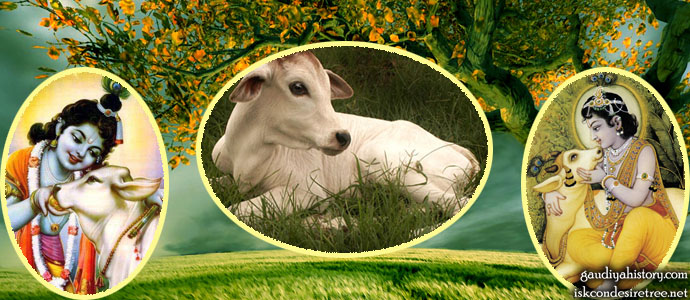
Needless to say, all of his disciples were amazed that Udupi Krishna personally served this non-'brahmin' farmer, but Shripad Vyasa Tirtha explained that, "No, the Lord had come to serve His pure Devotee. Previously He came for Acharya Madhva to have him glorified, and now he has found another worthy soul." Shripad Vyasa Tirtha later formally initiated the farmer as his disciple. (In the wallpaper: Shri Gopal with His cow).
